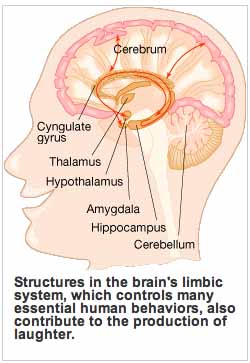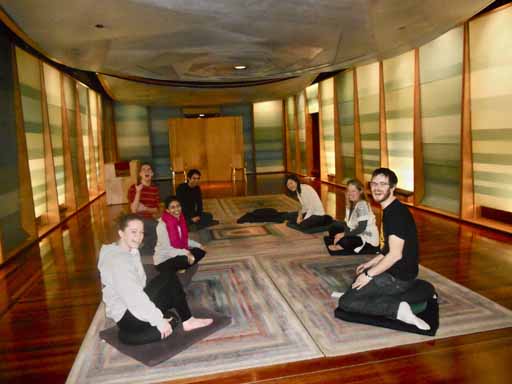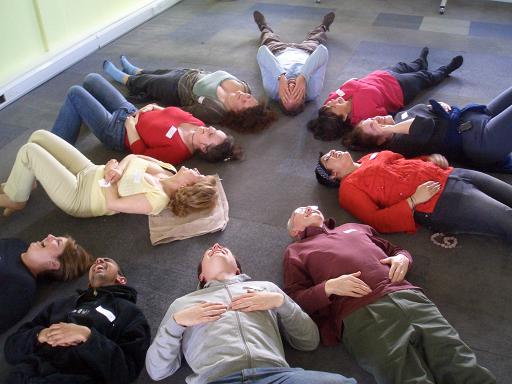

Laughter raises one's frequency to help with the healing process. In the duality of life - it's laughter and positive programming (genetics) vs. tears and personality disorders - usually anxiety and depression.
Laughing is a reaction to certain stimuli, fundamentally stress, which serves as an emotional balancing mechanism. Traditionally, it is considered a visual expression of happiness, or an inward feeling of joy. It may ensue from hearing a joke, being tickled, or other stimuli. It is in most cases a very pleasant sensation.
Laughter is found among various animals, as well as in humans, although it is more rare in most mammals and animals overall. Among the human species, it is a part of human behavior regulated by the brain, helping humans clarify their intentions in social interaction and providing an emotional context to conversations.
Laughter is used as a signal for being part of a group - it signals acceptance and positive interactions with others. It is sometimes seen as contagious, and the laughter of one person can itself provoke laughter from others as a positive feedback. This may account in part for the popularity of laugh tracks in situation comedy television shows.
Laughter is anatomically caused by the epiglottis constricting the larynx. The study of humor and laughter, and its psychological and physiological effects on the human body, is called gelotology.

Research by Dr. Robert Provine suggest that laughter is a form of communication, probably the first one in the human race, which later evolved, with the liberation of voice from walking and breathing, into human language.
Provine has spent decades studying laughter. In his interview for WedMD, he indicated that laughter is a mechanism everyone has - part of universal human vocabulary. There are thousands of languages, hundreds of thousands of dialects, but everyone speaks laughter in pretty much the same way.
Laughter is primitive, an unconscious vocalization. And if it seems you laugh more than other, Provine argues that it probably is genetic, as is everything we are programmed to do while in a physical body.
Babies have the ability to laugh before they ever speak. Children who are born blind and deaf still retain the ability to laugh. Even apes have a form of 'pant-pant-pant' laughter.
In a study of the 'Giggle Twins,' two exceptionally happy twins were separated at birth and not reunited until 40 years later. Provine reports that until they met each other, neither of these exceptionally happy ladies had known anyone who laughed as much as she did. They reported this even though they both had been reared by adoptive parents they indicated were undemonstrative and dour. Provine indicates that the twins inherited some aspects of their laugh sound and pattern, readiness to laugh, and perhaps even taste in humor.
Laughter therapy boosts the interferon levels of the immune system which helps the system's ability to fight illness and escalates healing. Laughter decreases stress hormones that constrict blood vessels and suppress immune activity.
Muscle Relaxation - Belly laugh results in muscle relaxation. While you laugh, the muscles that do not participate in the belly laugh, relaxes. After you finish laughing those muscles involved in the laughter start to relax. So, the action takes place in two stages.
Reduction of Stress Hormones - Laughter reduces at least four of neuroendocrine hormones associated with stress response. These are epinephrine, cortisol, dopac, and growth hormone.
Immune System Enhancement - Clinical studies have shown that humor strengthens the immune system.
Pain Reduction - Humor allows a person to "forget" about pains such as aches, arthritis, etc.
Cardiac Exercise - A belly laugh is equivalent to "an internal jogging." Laughter can provide good cardiac conditioning especially for those who are unable to perform physical exercises.
Blood Pressure - Women seem to benefit more than men in preventing hypertension.
Respiration - Frequent belly laughter empties your lungs of more air than it takes in resulting in a cleansing effect - similar to deep breathing. Especially beneficial for patient's who are suffering from emphysema and other respiratory ailments.

Principal fissures and lobes of the cerebrum viewed laterally. Modern neurophysiology states that laughter is linked with the activation of the ventromedial prefrontal cortex, which produces endorphins after a rewarding activity: after you have a good meal, after you have sexual intercourse and after you understand a joke. Research has shown that parts of the limbic system are involved in laughter. The limbic system is a primitive part of the brain that is involved in emotions and helps us with basic functions necessary for survival. Two structures in the limbic system are involved in producing laughter: the amygdala and the hippocampus.
It has been shown that laughing helps protect the heart. Although studies are not sure why laughing protects the heart, the studies do explain that mental stress impairs the endothelium, which is the protective barrier lining a person's blood vessels. Once the endothelium is impaired, it can cause a series of inflammatory reactions that lead to cholesterol build up in a person's coronary arteries, which can ultimately cause a heart attack.
From Psychologist Steve Sultanoff, Ph.D., the president of the American Association for Therapeutic Humor -- With deep, heartfelt laughter, it appears that serum cortisol, which is a hormone that is secreted when we're under stress, is decreased. So when you're having a stress reaction, if you laugh, apparently the cortisol that has been released during the stress reaction is reduced.
Laughter has been show to increase tolerance of pain and boost the body's production of infection-fighting antibodies, which can help prevent hardening of the arteries and subsequent conditions caused thereby such as angina, heart attacks, or strokes. Research shows that distressing emotions lead to heart disease. It is shown that people who are chronically angry and hostile have a greater likelihood for heart attack, people who live in anxious, stressed out lifestyles have greater blockages of their coronary arteries, and people who are chronically depressed have a two times greater change of heart disease.
A study in Japan shows that laughter lowers blood sugar after a meal. Keiko Hayashi, Ph.D., R.N, of the University of Tsukuba in Ibaraki, Japan, and his team performed a study of 19 people with type 2 diabetes. They collected the patients' blood before and two hours after a meal. The patients attending a boring 40 minute lecture after dinner on the first night of the study. On the second night, the patients attend a 40 minute comedy show. The patients' blood sugar went up after the comedy show, but much less that it did after the lecture. The study found that even when patients without diabetes did the same testing, a similar result was found. Scientists conclude that laughter is good for people with diabetes. They suggest that ‘chemical messengers made during laughter may help the body compensate for the disease.” WebMD 2003
Nearly 2/3 of people with asthma reported having asthma attacks that were triggered by laughter, according to a study presented at the American Thoracic Society annual meeting in 2005. It did not seem to matter how deep of a laugh the laughter entailed, whether it be a giggle, chuckle, or belly laugh, says Stuart Garay, M.D., clinical professor of medicine at New York University Medical Center in New York. Patients were part of an 18 month long program who were evaluated for a list of asthma triggers. The patients did not have any major differences in age, duration of asthma, or family history of asthma. However, exercise-induced asthma was more frequently found in patients who also had laughter-induced asthma, according to the study. 61% of laughter induced asthma also reported exercise as a trigger, as opposed to only 35% without laughter-induced asthma. Andrew Ries, M.D. indicates that “it probably involves both movements in the airways as well as an emotional reaction. - WebMD 2005
While it is normally only considered cliché that "laughter is the best medicine," specific medical theories attribute improved health and well-being to laughter. A study demonstrated neuroendocrine and stress-related hormones decreased during episodes of laughter, which provides support for the claim that humor can relieve stress. Writer Norman Cousins wrote about his experience with laughter in helping him recover from a serious illness in 1979's Anatomy of an Illness As Perceived by the Patient.
In 1989, the Journal of the American Medical Association published an article, wherein the author wrote that "a humor therapy program can increase the quality of life for patients with chronic problems and that laughter has an immediate symptom-relieving effect for these patients, an effect that is potentiated when laughter is induced regularly over a period". Some therapy movements like Re-evaluation Counseling believe that laughter is a type of "bodily discharge", along with crying, yawning and others, which requires encourgment and support as a means of healing.
There is well documented and ongoing research in this field of study. This has led to new and beneficial therapies practiced by doctors, psychiatrists, and other mental health professionals using humor and laughter to help patients cope or treat a variety of physical, mental, and spiritual issues. The various therapies are not specific to health care professionals or clinicians. Some of the therapies can be practiced individually or in a group setting to aid in a person's well-being. There seems to be something to the old saying "laughter is the best medicine".
It is also known as therapeutic humor. Using humorous materials such as books, shows, movies, or stories to encourage spontaneous discussion of the patients own humorous experiences. This can be provided individually or in a group setting. The process is facilitated by clinician. There can be a disadvantage to humor therapy in a group format, as it can be difficult to provide materials that all participants find humorous. It is extremely important the clinician is sensitive to laugh "with" clients rather than "at" the clients.
A client's laughter triggers are identified such as people in their lives that make them laugh, things from childhood, situations, movies, jokes, comedians, basically anything that makes them laugh. Based on the information provided by the client, the clinician creates a personal humor profile to aid in the laughter therapy. In this one on one setting, the client is taught basic exercises that can be practiced. The intent of the exercises is to remind the importance of relationships and social support. It is important the clinician is sensitive to what the client perceives as humorous.
Researchers frequently learn how the brain functions by studying what happens when something goes wrong. People with certain types of brain damage produce abnormal laughter. This is found most often in people with pseudobulbar palsy, gelastic epilepsy and, to a lesser degree, with multiple sclerosis, amyotrophic lateral sclerosis (ALS) , and some brain tumors. Inappropriate laughter is considered symptomatic of psychological disorders including dementia and hysteria. Some negative medical effects of laughter have been reported as well, including laughter syncope, where laughter causes a person to lose consciousness.
A number of competing theories have been written. For Aristotle, we laugh at inferior or ugly individuals, because we feel a joy at being superior to them. Socrates was reported by Plato as saying that the ridiculous was characterised by a display of self-ignorance. Schopenhauer wrote that it results from an incongruity between a concept and the real object it represents. Hegel shared almost exactly the same view, but saw the concept as an "appearance" and believed that laughter then totally negates that appearance. For Freud, laughter is an "economical phenomenon" whose function is to release "psychic energy" that had been wrongly mobilized by incorrect or false expectations.
In modern times, the tendency is toward acceptance of incongruity as the probable cause of laughter, and incongruity-based theories are slowly gaining ground, although other schools of thought still hold some favor. A common explanation of humor (in the broader sense of 'laughter-provoking') is based on language. Premise: as we interpret a text, we automatically consider what language says, supposes, doesn't say, and implies (this is the perspective of hermeneutics); the sentences we listen to and we tell, follow the universal conversational rules, that can be reduced to only one: be relevant.
This is the basis of the cognitive model of humor: the joke creates an inconsistency, the sentence appears to be not relevant, and we automatically try to understand what the sentence says, supposes, doesn't say, and implies; if we are successful in solving this 'cognitive riddle', and we find out what is hidden within the sentence, and what is the underlying thought, and we bring foreground what was in the background, and we realize that the surprise wasn't dangerous, we eventually laugh with relief. Otherwise, if the inconsistency is not resolved, there is no laugh, as Mack Sennett pointed out: "when the audience is confused, it doesn't laugh" (this is the one of the basic laws of a comedian, called "exactness"). This explanation is also confirmed by modern neurophysiology.

In laughter meditation there are some similarities to traditional meditation. However, it is the laughter that focuses the person to concentrate on the moment. Through a three stage process of stretching, laughing and or crying, and a period of meditative silence. In the first stage, the person places all energy into the stretching every muscle without laughter.
In the second stage, the person starts with a gradual smile, and then slowly begins to purposely belly laugh or cry, whichever occurs. In the final stage, the person abruptly stops laughing or crying, then with their eyes now closed they breathe without a sound and focus their concentration on the moment. The process is approximately a 15 minute exercise. This may be awkward for some people as the laughter is not necessarily spontaneous. This is generally practiced on an individual basis.

Somewhat similar to traditional yoga, laughter yoga is a exercise which incorporates breathing, yoga, stretching techniques along with laughter. The structured format includes several laughter exercises for a period of 30 to 45 minutes facilitated by a trained individual. Practiced it can be used as supplemental or preventative therapy. Laughter yoga can be performed in a group or a club.
Therapeutic laughter clubs are extension of Laughter Yoga, but in a formalized club format. The need for humorous materials is not necessarily required. Laughter yoga is similar to yogic asana and the practice of Buddhist forced laughter. Some participants may find it awkward as laughter is not necessarily spontaneous in the structured format. A growth of laughter-related movements such as Laughter Yoga, Laughing Clubs and World Laughter Day have emerged in recent years as a testament to the growing popularity of laughter as therapy. In China, for example, the popularity of Laughing Clubs has even led to a detailed lexicon of laughing styles, such as "The Lion Bellow" or "The Quarreling Laugh".
The Secret to Health and Happiness? Laughing at Yourself NBC - July 11, 2017
Laughter Can Make People Feel More Comfortable And Reveal Their Secrets Huffington Post - March 31, 2015
They say laughter is the best medicine, but new research suggests it could also make people more likely to reveal their secrets. A study published in Human Nature found that cracking up is a catalyst for opening up: It makes people more likely to share personal details about themselves.
Brain Images Reveal How We Distinguish Real and Fake Laughter Live Science - April 2, 2014
It was Victor Borge, the famous Danish comedian, to whom we can attribute the quote: “Laughter is the shortest distance between two people”. And he was right, laughter is universal in human cultures and plays a very important social function. A form of laughter is also seen in other social species such as chimpanzees and bonobos, and even rats. From as young as six weeks old, human babies begin to smile and laugh in response to tickling and tactile interactions. This is a crucial stage in the formation of social bonds and something we continue to do throughout our lives. When we are adults, we laugh much more frequently during conversation than in any other activity. Laughing together with friends and loved ones signals our affiliation with them and our desire to maintain social bonds. So while conversational laughter is often much less intense than the laughter we make when being tickled or when watching our favorite comedy shows, it serves a very important purpose.
Study reveals laughter really is the best medicine BBC - September 14, 2011
People feel less pain after a good laugh, because it may cause the body to release chemicals that act as a natural painkiller, research has suggested. The researchers at the University of Oxford also think the ability to belly laugh was unique to early humans. This, they believe, enabled our ancestors to form much larger tribal groupings than the ape-like species that lived alongside them.
No laughing matter: Laughter can play key role in group dynamics PhysOrg - August 24, 2010
Laughter can play key roles in group communication and group dynamics - even when there's nothing funny going on. That's according to new research from North Carolina State University that examined the role of laughter in jury deliberations during a capital murder case.
Laughter can convey a range of emotions, each processed by a different part of the brain PhysOrg - July 19, 2010
Everybody enjoys a laugh but new research from an international team shows it's not as simple as you might think.
Laughter Affects Body Like Exercise Live Science - April 26, 2010
Is laughter the new exercise? Quite possibly. While toning thighs and building muscle mass still require a trip to the gym, other benefits associated with exercise - improved cholesterol and blood pressure, decreased stress hormones, a strengthened immune system and a healthy appetite - can be attained with regular guffaws, studies now suggest. The latest mirth study, which focuses on the appetite effects of a good laugh, is being presented this week at the 2010 Experimental Biology conference in Anaheim, Calif.
Laughter: Not Just for Funny Stuff Live Science - July 9, 2009

Scientists say there are two types of laughter: the kind that comes from pure glee, and the kind that's meant to send a social message. New research suggests autistic children don't often express the latter type, a finding that could reveal more about the nature of human laughter.
Positive emotions increase life satisfaction by building resilience PhysOrg - July 8, 2009
People who seed their life with frequent moments of positive emotions increase their resilience against challenges, according to a new study by a University of North Carolina at Chapel Hill psychologist and colleagues.
Laughter Really Is Contagious - Live Science - December 14, 2006

If you see two people laughing at a joke you didn-t hear, chances are you will smile anyway even if you don't realize it. According to a new study, laughter truly is contagious: the brain responds to the sound of laughter and preps the muscles in the face to join in the mirth. "It seems that it's absolutely true that ‘laugh and the whole world laughs with you," said Sophie Scott, a neuroscientist at the University College London. "We've known for some time that when we are talking to someone, we often mirror their behavior, copying the words they use and mimicking their gestures. Now we've shown that the same appears to apply to laughter, too at least at the level of the brain."
Scott and her fellow researchers played a series of sounds to volunteers and measured the responses in their brain with an fMRI scanner. Some sounds, like laughter or a triumphant shout, were positive, while others, like screaming or retching, were negative. All of the sounds triggered responses in the premotor cortical region of the brain, which prepares the muscles in the face to move in a way that corresponds to the sound. The response was much higher for positive sounds, suggesting they are more contagious than negative sounds which could explain our involuntary smiles when we see people laughing. The team also tested the movement of facial muscles when the sounds were played and found that people tended to smile when they heard laughter, but didn't make a gagging face when they heard retching sounds, Scott told LiveScience. She attributes this response to the desire to avoid negative emotions and sounds.
The contagiousness of positive emotions could be an important social factor, according to Scott. Some scientists think human ancestors may have laughed in groups before they could speak and that laughter may have been a precursor to language. "We usually encounter positive emotions, such as laughter or cheering, in group situations, whether watching a comedy program with family or a football game with friends," Scott said. "This response in the brain, automatically priming us to smile or laugh, provides a way or mirroring the behavior of others, something which helps us interact socially. It could play an important role in building strong bonds between individuals in a group." Scott and her team will be studying these emotional responses in the brain in people with autism, who have general failures of social and emotional processing to better understand the disease and why those with it don't mirror others emotions.
Where Did Laughter Come From? - Discovery - October 7, 2003
Laughter may pre-date human evolution. The special sounds and gestures made by infant bonobos also
known as pygmy when they are tickled suggest that the origins of laughter may pre-date human evolution, according to a new report. A study of a young bonobo in a German zoo found that when it was tickled it combined vocalizations and facial gestures much like those made by human infants, said the report in the BioMednet science news service. The finding suggests that the rules for how emotion is encoded behaviorally were laid down in the common ancestor humans shared with other great apes, Elke Zimmermann of the Institute of Zoology at the Tieraerztliche Hochschule, in Hanover, told a recent conference of the German Primate Society. The sounds made by the bonobo when tickled during its first year of life were carefully recorded at Wuppertal Zoo eight years ago by another researcher, Birgit Förderreuther, who was unable to continue the study due to illness, the report said.
Now Zimmerman has conducted a sophisticated analysis of the recordings and compared them with sounds made by human babies when they are tickled. She found that the bonobo's vocalizations followed broadly the same spectrographic pattern - a technique that depicts the changes in frequency and intensity of the sound over time - as that of human infants, except that the bonobo's laugh was at higher frequencies. Infant bonobos and humans both combine those sounds with a facial gesture known as a relaxed open-mouth display. Zimmerman believes that her findings confirm a hypothesis that laughter originated in primates, as a universal signal of wellbeing in a playful situation to help regulate social interactions, the report said. A pre-human evolutionary origin for laughter could also explain why it is still present in deaf and blind infants, and why it fulfills the same role - and sounds the same - in people from different cultures.
Laughter is well documented in common chimpanzees, with observations of both wild and captive chimpanzees revealing that they even share with humans the same ticklish anatomical regions - the armpits and belly. Chimpanzee laughter, however, involves a more rapid panting action with sound made on both inhalation and exhalation of air. Human laughter tends to involve sound made mainly on exhalation. Chimpanzees are also known to continue enjoying tickling well into adulthood. Among young chimpanzees that have been taught sign language, tickling is a frequent topic of conversation, according to a recent article on the biology of laughter in Discover magazine. But chimpanzee laughter usually happens in a different social context than it does in humans: chimps laugh almost exclusively during physical contact, or when contact is imminent during chasing and wrestling games, whereas most adult human laughter occurs during conversation without touching being involved, according to Robert Provine, a psychologist at the University of Maryland, who is an authority on laughter.
Jokes activates same brain region as cocaine - Nature - December 4, 2003
Humor tickles drug center that gives hedonistic high. There's truth in the maxim 'laughter is a drug'. A comic cartoon fired up the same brain centre as a shot of cocaine, researchers are reporting. A team at Stanford University in California asked lab mates, spouses and friends to select the wittiest newspaper cartoons from a portfolio. They showed the winning array to 16 volunteers while peering inside their heads by functional magnetic resonance imaging (MRI).
The cartoons activated the same reward circuits in the brain that are tickled by cocaine, money or a pretty face, the neuroscientists found. One brain region in particular, the nucleus accumbens, lit up seconds after a rib-tickler but remained listless after a lackluster cartoon. The nucleus accumbens is awash with the feelgood chemical dopamine. The region's buzz may explain the euphoria that follows a good joke, the team suggests. "Intuitively, it makes sense," agrees Bill Kelley, who studies humor at Dartmouth College in Hanover, New Hampshire.
Earlier investigations found that humor triggers brain regions that work out a joke's language and meaning, or those that smiling and laughter. Kelley, for example, has studied people's brains while they watched episodes of television comedies Seinfeld and The Simpsons. "It's surprising it's not consistent," he says. A powerful MRI machine and a particularly detailed analysis may explain why the new study picked up activity in the reward areas as well, suggests lead researcher Allan Reiss who hopes that the finding could help to diagnose the early stages of depression or show whether antidepressants are taking effect during which people's appreciation of humor is altered.
Why do we laugh? - NBC - July 2, 2002
Laughter is part of the universal human vocabulary. All members of the human species understand it. Unlike English or French or Swahili, we don't have to learn to speak it. We're born with the capacity to laugh. One of the remarkable things about laughter is that it occurs unconsciously. You don't decide to do it. While we can consciously inhibit it, we don't consciously produce laughter. That's why it's very hard to laugh on command or to fake laughter. (Don't take my word for it: Ask a friend to laugh on the spot.)
Laughter provides powerful, uncensored insights into our unconscious. It simply bubbles up from within us in certain situations. Very little is known about the specific brain mechanisms responsible for laughter. But we do know that laughter is triggered by many sensations and thoughts, and that it activates many parts of the body. When we laugh, we alter our facial expressions and make sounds. During exuberant laughter, the muscles of the arms, legs and trunk are involved. Laughter also requires modification in our pattern of breathing. We also know that laughter is a message that we send to other people. We know this because we rarely laugh when we are alone (we laugh to ourselves even less than we talk to ourselves).
Laughter is social and contagious. We laugh at the sound of laughter itself. That's why the Tickle Me Elmo doll is such a success - it makes us laugh and smile. The first laughter appears at about 3.5 to 4 months of age, long before we're able to speak. Laughter, like crying, is a way for a preverbal infant to interact with the mother and other caregivers. Contrary to folk wisdom, most laughter is not about humor; it is about relationships between people. To find out when and why people laugh, I and several undergraduate research assistants went to local malls and city sidewalks and recorded what happened just before people laughed. Over a 10-year period, we studied over 2,000 cases of naturally occurring laughter. We found that most laughter does not follow jokes. People laugh after a variety of statements such as "Hey John, where ya been?" "Here comes Mary," "How did you do on the test?" and "Do you have a rubber band?" These certainly aren't jokes. We don't decide to laugh at these moments. Our brain makes the decision for us. These curious "ha ha ha's" are bits of social glue that bond relationships. Curiously, laughter seldom interrupts the sentence structure of speech. It punctuates speech. We only laugh during pauses when we would cough or breathe.
From an evolutionary perspective, we believe laughter evolved from the panting behavior of our ancient primate ancestors. Today, if we tickle chimps or gorillas, they don't laugh "ha ha ha" but exhibit a panting sound. That's the sound of ape laughter. And it's the root of human laughter. Apes laugh in conditions in which human laughter is produced, like tickle, rough and tumble play, and chasing games. Other animals produce vocalizations during play, but they are so different that it's difficult to equate them with laughter. Rats, for example, produce high-pitch vocalizations during play and when tickled. But it's very different in sound from human laughter.
When we laugh, we're often communicating playful intent. So laughter has a bonding function within individuals in a group. It's often positive, but it can be negative too. There's a difference between "laughing with" and "laughing at." People who laugh at others may be trying to force them to conform or casting them out of the group. No one has actually counted how much people of different ages laugh, but young children probably laugh the most. At ages 5 and 6, we tend to see the most exuberant laughs. Adults laugh less than children, probably because they play less. And laughter is associated with play.